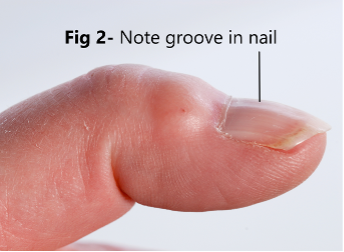Ganglion (Mucus Cyst)
Ganglions are the commonest soft tissue masses found in the hand, especially common in females between the ages of 20 and 40. They present as a smooth lump near a joint or tendon and are filled with a jelly-like (mucin) content communicating with the joint. The common sites are:
- Back of wrist in line with the forefinger (Scapho-lunate joint)
- Front of wrist near Radial artery pulse- Fig 1.
- Front of finger base (Flexor-sheath or Seed-Ganglion, near A1 pulley)
- Base of nail (TIP joint Mucus Cyst- associated with arthritis). Here there is a tell-tale grooving of the nail due to pressure on the growth area of the nail- Fig 2.
However, ganglions can occur almost anywhere and can be quite large (Fig 3). They get confused sometimes with other entities such as Tenosynovitis, Lipomas, GCT (Giant Cell Tumour of tendon sheath) and Schwannomas or Neurofibromas. Apart from being unsightly, they can be associated with pain (especially when knocked), weakness and, in the case of fingertip mucus cysts, discharge and infection.
Ganglions can exist in their own right or as a sign of underlying pathology such as skeletal instability. It is therefore important to diagnose and treat the underlying cause, and to appreciate that pain may not go away merely by removing the ganglion.
Early small asymptomatic ganglions can be left alone as they may resolve spontaneously- hitting with the family Bible is no longer recommended! If larger, persistent or symptomatic, a stepwise escalation of treatment can be tried:
- Some ganglions can be emptied by aspirating under local anaesthetic in Clinic itself if the contents are not too viscous. This may not work, and even if it does about 2/3 of the time the ganglion fills up again.
- Surgery is more successful, especially when done by a Hand Surgeon under magnification when the stalk communicating with the joint is pursued and removed along with the entire ganglion sac and any tiny outpouchings or daughter loculi. Recurrence can still occur but is much less common.
In all instances it is important to ascertain a cause such as carpo-metacarpal boss or osteophytes from arthritis. The latter are commonly the cause in TIP joint mucus cysts and must be carefully nibbled away if recurrence is to be avoided. The workup for ganglions therefore may necessitate acquiring X-Rays or more sophisticated imaging modalities if the Surgeon feels merely removing the ganglion will not relieve the pain. Sometimes formal physiotherapy may be required to relieve postoperative stiffness; this is uncommon and a rapid return to function can be expected.



